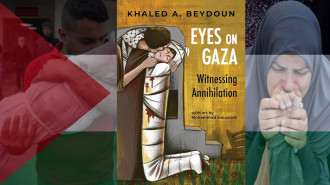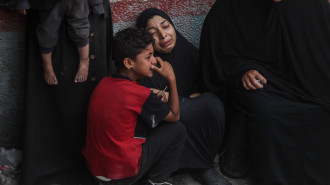
Wearing her keffiyeh loud and proud, MEP Rima Hassan is determined to ensure Palestine remains an urgent matter in European political discourse

In the heart of every movement, there are symbols that encapsulate its essence and aspirations; for Palestinians, the keffiyeh represents that potent emblem of resistance and identity.
"Destroying symbols is also erasing a cause," begins Rima Hassan, who made history by becoming the first French-Palestinian member of the European parliament. The 32-year-old human rights activist, lawyer, and refugee advocate gained a significant following thanks to her activism for Gaza amid Israel's ongoing war.
However, on September 17, Rima was reprimanded by the European Parliament for wearing the keffiyeh during a plenary session.
"I believe there is such tension around this symbol precisely because it traces our entire story. It’s like a second flag"
The German president of the session requested that she remove the keffiyeh before speaking at the podium. Rima responded that she wears the scarf daily while seated in the parliament and argued for her right to wear it while speaking. But she was then warned that she would be prohibited from taking the floor unless she removed the scarf, according to the rules of procedure.
Rima's experience is not isolated. Just weeks later, on October 23, Spanish MEP Irene Montero faced similar opposition when she was forced to remove her keffiyeh before addressing the European Parliament.
Irene Montero condemned Europe’s support for Israel, calling it complicit in what she described as a "genocide" in Gaza and Lebanon, through arms sales. She called for an end to European complicity in the violence and labelled Israel a "terrorist state" for its actions.
"I believe there is such tension around this symbol precisely because it traces our entire story. It’s like a second flag," Rima tells The New Arab.
More than just a fabric
The keffiyeh, worn throughout history, represents a significant aspect of the Palestinian quest for recognition.
This traditional scarf, which emanated to prominence from the streets of Palestine during the 1936-1939 Arab Revolt, has become an unmistakable marker of identity. Initially used by Palestinian soldiers to distinguish themselves from their Jordanian allies, it evolved into an international symbol of rebellion worn by the likes of Laila Khaled and Nelson Mandela.
The keffiyeh even stood in place of the banned Palestinian flag from 1967 to 1993.
“It’s more than just a piece of fabric; it’s a narrative woven into the fabric of our existence,” Rima continues, emphasising that the keffiyeh embodies the collective memory of a people facing systemic erasure.
Rising repression of pro-Palestinian voices
In recent years, pro-Palestinian symbols have faced heightened repression, particularly in Europe.
France has become a focal point, where expressions of Palestinian solidarity are increasingly criminalised. Pro-Palestinian expressions are met with an iron fist — flags are confiscated at events like the Olympics, and activists are arrested. This crackdown is selective and systemic.
“The Palestinian cause today is a barometer, a compass,” says Rima.
Concerns over freedom of expression in France are intensifying and critics argue that these actions threaten the balance between free expression and the need to combat hate speech.
"It’s the pressure from civil society that can make the difference"
The road ahead for the Palestinian cause in European politics faces significant hurdles, especially in the European Parliament, which leans heavily to the right. This political climate puts substantial barriers to the passing of resolutions in support of Palestinian rights.
“There is little hope of passing legislation through votes alone,” Rima acknowledges.
She says she is not blind to the structural limitations of parliamentary processes. The 2002 European Parliament vote to suspend the EU-Israel Association Agreement — despite passing — was ultimately blocked by the European Commission, a reminder of how difficult it can be to translate votes into tangible action.
This history of political gridlock zeroes in on the need for broader strategies that transcend parliamentary limitations. Where legislative efforts may falter, the power of civil society as a critical and transformative force can chime in.
Rima believes that renewed pressure from civil society could reinvigorate the movement. Drawing comparisons to the anti-apartheid movement in South Africa, the French Palestinian politician insists on the potential of grassroots mobilisation to shift the political landscape.
"It’s the pressure from civil society that can make the difference," Rima explains. She envisions a coordinated effort between NGOs, international organisations, and citizens to push the Palestinian cause forward, echoing the boycotts, petitions, and public campaigns that isolated South African decision-makers in the 1980s.
Pushing for change
In recent months, the Euro-deputy has engaged in extensive consultations with NGOs based in Palestine and within the diaspora, as well as with institutions such as Amnesty International and the United Nations High Commissioner for Refugees (UNHCR).
This collaboration is designed to prioritise advocacy efforts on key issues, including an arms embargo on Israel, the ongoing humanitarian crisis in Gaza, and the rights of Palestinian prisoners, particularly children held in Israeli detention.
“There are so many pressing issues,” Rima notes, “from apartheid to the labelling of products from Israeli settlements.” Her objective is to build a cohesive strategy, focusing on areas where civil society can have the greatest impact and where political leaders can be pushed to act.
The International Criminal Court (ICC) is currently investigating allegations of genocide and war crimes in the region, and recently, the UN General Assembly adopted a draft resolution sponsored by Palestine, urging Israel to withdraw from occupied territories within one year.
This resolution was based on an advisory opinion from the International Court of Justice (ICJ) declaring Israel's occupation illegal under international law.
“We’re entering a new phase,” Rima says, pointing to legal scholars’ predictions that more key rulings will emerge within the next few years. These decisions, alongside civil society’s pressure, could dramatically alter the course of Palestinian advocacy in Europe.
“When I wear the keffiyeh, I don’t even need to speak; it already speaks volumes"
In the meantime, Rima is determined to ensure that the Palestinian cause remains a visible and urgent matter in European political discourse. She has already begun facilitating meetings between NGOs and European parliamentarians, aiming to ensure that the priorities of civil society are heard and represented.
It is crucial to acknowledge that symbols can provoke strong reactions, both supportive and adversarial. The keffiyeh, in particular, has evolved beyond a mere article of clothing; it has become a contentious emblem of resistance, and the Palestinian struggle.
The keffiyeh Rima Hassan dons symbolises more than identity; it conveys a powerful message about resilience and recognition.
“When I wear the keffiyeh, I don’t even need to speak; it already speaks volumes.”
Chaima Gharsallaoui is a journalist and filmmaker from Paris
Follow her on Instagram: @chaimagharsallaoui





 Follow the Middle East's top stories in English at The New Arab on Google News
Follow the Middle East's top stories in English at The New Arab on Google News


